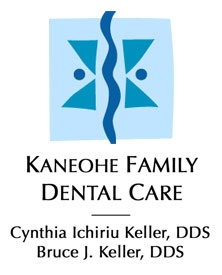My Dentist Says I Need a Crown!

Everyday at Kaneohe Family Dental Care, we are delighted to meet new patients looking for a Windward dentist. A good number of our new patients have already seen a Kaneohe or Kailua dentist and come to us asking for a second opinion regarding the treatment recommendations they have received. They choose Kaneohe Family Dental Care because it is annually listed as Best dentist Kailua and Kaneohe, they have been referred by a family member or friend, or they have read reviews on RateADentist.com, Google, or Yelp.
One of the most frequent questions we receive from our new patients is, “Do I need my tooth crowned, why can’t I just have a filling?” We are always happy to give our opinion after carefully evaluating the patient and reviewing all the information available. The following information will help you understand what a crown is and why it may be necessary for your tooth.
A dental crown, also called a “cap”, is a restoration that your dentist covers your tooth with to protect the tooth from breaking, replace and tooth’s missing structure, improve the appearance of a tooth, or any combination thereof.
Often, when teeth are examined visually, especially under magnification, crack lines are noticeable. Cracks in teeth can be very obvious or extremely subtle and are usually caused by impact injuries, habitual tooth grinding or clenching, or chewing hard or very tough foods. Cracked teeth may be painless or extremely painful when biting or at rest. Left untreated, cracked teeth, even if they do not hurt, usually result in the need for root canal treatment or tooth extraction. Crowns are placed on cracked teeth to stop cracks from spreading and prevent tooth fracture.
Occasionally, teeth are so badly damaged by decay or injury that a filling simply will not restore the tooth adequately. Due to material and mechanical reasons, fillings have size limitations. Large fillings can also make teeth more susceptible to fracture. In situations where fillings are not advisable, crowns are preferred to restore and protect the tooth.
Have you ever seen a TV or movie star and wondered how their teeth could look so perfect? Are these beautiful people endowed with a rare and special gene for a “Hollywood smile”? Probably, not! Dentistry can do amazing things to enhance anyone’s appearance. Having your teeth crowned or “capped” is one way available to make rapid changes in the shape and color of teeth.
Materials used to make crowns can be metal, usually gold, or tooth colored materials such as porcelains. Crowns can also be made of metal covered by porcelain. All porcelain crowns have become the most popular choice for the majority of situations as dental science has made spectacular advancements with porcelain materials. These advancements are due to consumer desire to have better looking and metal free restorations. The decision about which material is best for your tooth should be based on where the tooth is located in your mouth, your bite and functional requirements, how important the tooth is to your appearance, and financial considerations.
To make a crown, depending on the material it will be constructed of and the condition of the tooth, 0.5mm – 2 mm is removed from the biting surface of a tooth, and 0.5mm – 1.5mm is from around the sides of a tooth. After the preparation of the tooth is complete, an impression of the tooth is then taken and a temporary crown is placed on your tooth. The impression is used to fabricate the crown to exact specifications for shape and color. Later the temporary crown is removed and the completed crown is bonded to the tooth. Recently, methods have become available, and are employed by some dentists, to fabricate crowns in one appointment eliminating the need for temporary crowns and second appointments for final crown cementation. This process is advancing rapidly, but currently there are important limitations regarding the materials that can be used and the appearance of the final crown.
For more information about crowns and any dental topics or if you are searching for a Kaneohe or Kailua dentist, please contact Kaneohe Family Dental Care at www.kaneohefamilydental.com.
